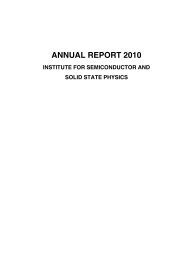Kinetic and Strain-Induced Self-Organization of SiGe ...
Kinetic and Strain-Induced Self-Organization of SiGe ...
Kinetic and Strain-Induced Self-Organization of SiGe ...
You also want an ePaper? Increase the reach of your titles
YUMPU automatically turns print PDFs into web optimized ePapers that Google loves.
16 CHAPTER 2. MOLECULAR BEAM EPITAXY (MBE)<br />
Figure 2.1: The relationship between the fundamental units encountered in vacuum<br />
technology [56].<br />
� Source: MBE vacuum.jpg<br />
ture in ultra-high-vacuum (UHV). Total pressures <strong>of</strong> the residual gas in the reactor below<br />
p ≤ 1.33 × 10 −7 Pa (10 −9 Torr) are called UHV. The composition <strong>of</strong> the grown epilayer <strong>and</strong><br />
its doping level is adjusted via the relative arrival rates <strong>of</strong> the different constituents by con-<br />
trolling the beam fluxes <strong>of</strong> the various sources. Usual growth rates are in the range <strong>of</strong> about<br />
1.5 monolayer (ML) per second (i.e. ∼ 1.5 ˚A/s). This moderate growth rate ensures sufficient<br />
surface migration <strong>of</strong> the impinging particles <strong>and</strong> therefore provide a smooth surface (also<br />
depending on the substrate temperature TS; higher TS enhances surface mobility). With the<br />
help <strong>of</strong> simple mechanical shutters in front <strong>of</strong> each <strong>of</strong> the beam sources the whole growth<br />
procedure or just the deposition <strong>of</strong> single constituents or dopants can be started, stopped<br />
or interrupted; that guarantees sharp borders or changes in composition <strong>and</strong> doping on an<br />
atomic scale, at least as long as segregation effects are thermally suppressed.<br />
In order to preserve one <strong>of</strong> the major characteristic features <strong>of</strong> MBE-growth – that is<br />
the beam nature <strong>of</strong> the mass flow towards the substrate – it is an indispensible requirement<br />
that ultra-high vacuum conditions are ensured. There are another two parameters closely<br />
related to the pressure p <strong>of</strong> the residual gas in the growth-chamber, namely the mean free<br />
path lmfp <strong>and</strong> the concentration nconc <strong>of</strong> the gas molecules travelling through the volume<br />
towards the target-substrate. Mean free path is the average distance <strong>of</strong> a molecule between<br />
two successive collisions, whereas the concentration is simply the number <strong>of</strong> species per unit<br />
volume. Large values for lmfp are not only necessary to avoid high scattering rates (that<br />
would destroy the beam-like nature), but also to minimize atoms from the residual gas to











